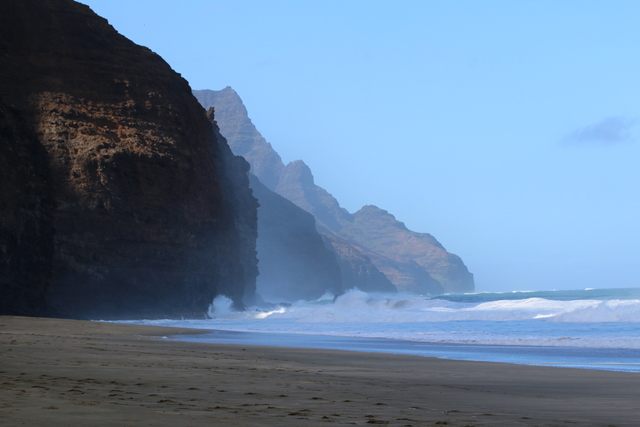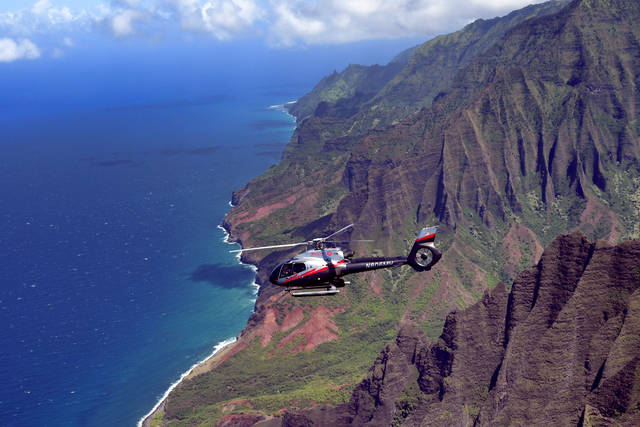KAUAI, Hawaii — As I hurtled through the sky above a sprawling valley, in view of sapphire waves and verdant mountain slopes, the wind was whipping past me and my eyes were streaming tears.
My lips were peeled back, I was yelling incomprehensibly and my brain was blaring, “This could be the end.”
But let me begin at the beginning, before I zoomed down a three-quarter-mile zip line on Kauai, the westernmost of the well-populated Hawaiian Islands.
I had never been to the so-called Garden Island, but I knew it by reputation. Less built up than Maui and Oahu, Kauai is blessed with spectacular hiking trails, secluded beaches and dramatic vistas.
That made it an ideal warm-weather destination to rev up and unwind, while talking to residents opened my eyes to Kauai’s history and the consequences of more mainlanders visiting the island.
Through the air and up the coast
Were I to visit Kauai again, I might concentrate on a particular pastime. But on this trip with friends, I tried both exciting and relaxing activities.
Which brings me back to my midair moment, courtesy of the FlyLine, a special zip line operated by Outfitters Kauai, which also offers kayak, bike and stand-up paddleboard tours.
The company has several zip-line packages. Looking for thrills, we chose the so-called AdrenaLine excursion. It began with a pair of conventional zip lines, which allowed us to soar over the trees.
Then some of us stripped into our swimsuits and jumped off a mini zip line into a water hole hidden in the muggy jungle, where we gaped at tropical plants with fronds longer than my arm.
The biggest thrill came last, however. The FlyLine starts atop a wooden tower several stories tall. Below is Kipu Ranch, where the movie “Jurassic Park” shot scenes.
Strapped into a hammock-like harness, I swung horizontal, then swooped across the valley in a superman pose. Outfitters Kauai says zip liners reach 50 mph.
Others in the group were less scared than I. They coasted down in serene style, extending their arms like birds.
Hiking with chickens
Speaking of birds, chickens rule Kauai. Scientists believe their numbers surged in 1992, after a
hurricane destroyed farms, setting birds free.
The strangest spot I saw a rooster was Hanakapi’ai Beach, a rocky cove two miles up the renowned Kalalau Trail. The trail runs along western Kauai’s Napali Coast, where sparkling waves crash spectacularly against plunging mountains.
To get there, drive counterclockwise on the island’s outer highway until you run out of road. We stayed in Kapa’a, on the east shore, and the drive took us about an hour.
Next to the trailhead is Ke’e Beach, where we watched an endangered Hawaiian monk seal enjoy a nap on the sand.
The sun was out for our hike, which made the coast’s colors really pop. Rest breaks are the best part of the trek, thanks to the views: The ocean couldn’t have been more blue and the hillside couldn’t have been more green. Tropical flora — lauhala and banana trees, ohia lehua and ti plants — offer shade and wonder.
When hiking, you can expect to sweat. There are steep sections and my boots grew heavy with squelchy, red mud.
Budget about an hour per mile, bring water bottles and take care not to slip when crossing Hanakapiai Stream.
On the beach and on the shelf
That’s easy on Kauai, because there are quiet beaches everywhere you go.
The strand we’ll remember best is the crook of Lumahai Beach by Makahoa Point. Park your car in the unpaved area on the ocean side of Kuhio Highway just west of Hanalei, where the road takes a sharp twist.
Then look for a gap between the trees, where a path leads down to the beach.
You’ll see smooth yellow sand, frothy surf and jet-black volcanic rocks being pummeled by waves. When we were there, waves washing over the rocks had created a sandy wading pool.
The beach appears wild and remote, and for about an hour, we were alone. Though the quiet stretch is no secret, it was easy to pretend that it was.
We decided to stick to the shallows, partly because there was no lifeguard. Many Kauai beaches have signs warning about dangerous riptides and Lumahai is known for strong undertow and currents that make swimming here dangerous.
Rather than swim, we stood knee-deep in the sparkling tide, listened to the ocean and drank in the scenery.
The other end of Lumahai Beach, where a river meets the ocean, is also pretty. But a parking lot and easy access make it more crowded.
That’s the overall trend on Kauai, where tourism has surged in recent years. Though the island relies on tourism, its residents are dealing with more traffic, more construction and more visitors who have a lot to learn about local history and culture.
“The taro patches were always here but the rest was all bush,” said Keola Yokotake, talking about development near Hanalei. Yokotake sings Hawaiian songs and plays ukulele at Hanalei’s Saturday Farmers Market.
“People aren’t too happy about the traffic. We never had backups before. Now the traffic never ends,” he said.
Kauka says tourists can show respect by adopting a patient, upbeat attitude on the road, in eateries and in stores. “Take a deep breath,” she said. “Make the beauty last and just slow down.”
If you go
Visit Kauai’s north shore for mist and the south shore for sun.
* Stop by Hamura’s Saimin in Lihue for old-school noodles. 2956 Kress St.; yelp.com/biz/hamuras-saimin-lihue.
*Need a beach book? Browse the shelves at Talk Story Bookstore in Hanapepe: talkstorybookstore.com.


